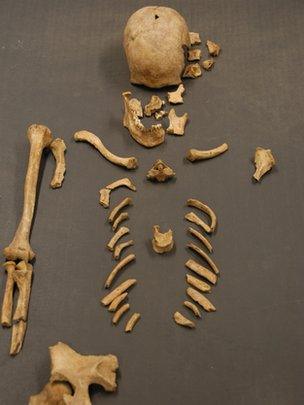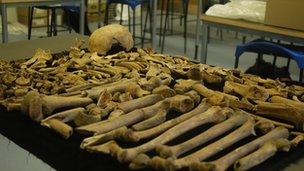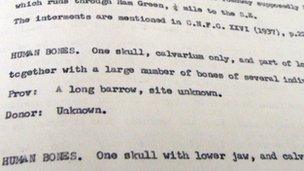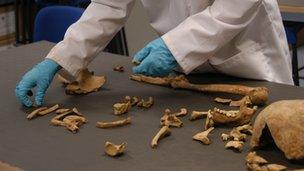Human bones in Gloucester museum 'not from Stone Age' after all
- Published

The bones have been in storage for more than a century
A set of human bones at Gloucester museum, always believed to be from the Stone Age, are now thought to be only about 500 years old.
The remains, which have been in storage for more than a century, were labelled "from a long barrow".
Long barrows are ancient Neolithic burial sites from about 6,000 years ago, but radio carbon dating has shown the bones date to between 1523 and 1799.
Gloucester museum's archaeology curator, David Rice, said he was "surprised" by the results.
The box of bones, containing partial remains from at least six individuals, was first officially recorded in a stock take, at what is now Gloucester City Museum and Art Gallery, in the 1950s.
An entry in a ledger from the time reads: "Human bones. One skull, calvarium [upper part of skull] only and part of a lower jaw, together with a large number of bones of several individuals, from a long barrow - site unknown, donor unknown".
'Prehistoric site'
The box contained 262 human bone fragments, ranging from complete arm bones to tiny skull fragments.
Mr Rice said: "The bones had been in storage in a cardboard box. All we had to go on was what was written down in the books."

The box contained 262 human bone fragments, including complete arm bones
The museum decided to send the relics away for testing, using modern techniques.
Archaeologist Emily Trapnell from Bournemouth University, who carried out the tests on one of the bones from an adolescent, said: "Initially the bones seemed to fit the description of what you'd expect to find from a Neolithic long barrow.
"The remains were very fragmented, and there was also some animal bone amongst them."
'Definitely a shock'
Ms Trapnell said the intention had been to try to identify the geographical location of the long barrow they came from, by testing soil from the bones and using published literature to try to find a match.
"However after radio carbon dating we found the bones date from between 1523 and 1799 so they are actually modern rather than Neolithic.
"It was definitely a shock," she said.

The mystery bones were first recorded in a museum stock take in the 1950s
The analysis also suggested that at least one of the skeletons was from a different site to the other bones, but where, exactly, is still unknown.
Mr Rice said: "Usually we believe everything that's written on a label in a museum, but it seems that something's happened here."
There are now various theories which could explain the date being a lot more recent than expected.
One idea is that whoever dug them up wrongly thought they were digging in a long barrow.
'Smoked big pipes'
"Or it could be the bones are contaminated," added Mr Rice.
"These old curators, they all smoked big pipes and passed things around amongst each other, and it could be that some of their material has rubbed off [which could have produced an error in the radio carbon dating]."
The museum said the bones would now have to be re-labelled, and more detailed tests would be carried out if funding could be secured, but there was no guarantee the bones would go on show to the public.

Tests have been carried out on the bones at Bournemouth University
"You have to be very respectful," said Mr Rice. "You have to remember these are real people.
"We have got a human remains policy that lays out exactly how they can be seen, how they can be handled and how they should be treated.
"If they're proved to be modern and of no use to the scientific community then we probably owe it to them to rebury them.
"But if they are prehistoric and pagan, to give them a Christian burial ceremony would perhaps be the wrong thing to do," added Mr Rice.
- Published7 June 2011
- Published20 July 2010